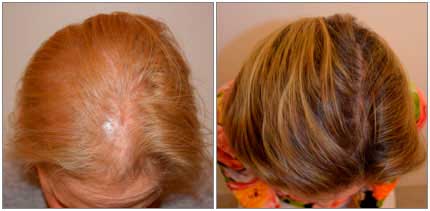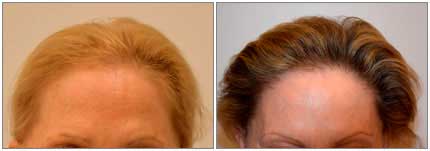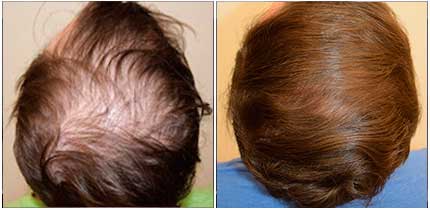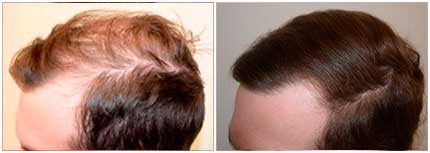PLATELET-RICH PLASMA (PRP)
Written by Dr. Griffin
Non-Surgical Hair Loss Treatments
In the interest of providing our hair loss patients with every potentially effective therapy, The Griffin Hair Restoration Center provides PRP for Philadelphia-area patients seeking injections in conjunction with hair replacement surgery. PRP, which stands for platelet-rich plasma, is the product of using one’s own blood obtained by centrifuging a sample of drawn from the arm. The resulting fluid, as the name implies, contains high concentrations of platelets, which are the clotting cells in the blood.
Platelets are cells that are very active in the early phases of wound healing. They contain growth factors in their cytoplasm that promote tissue regeneration and renewal. These growth factors have the ability to stimulate hair follicle stem cells, leading to a prolonged growth phase and a resultant stronger and more lustrous hair. PRP is done in conjunction with a regular daily hair care regimen, which will maintain the hair while it improves and continue to maintain it after it improves.
Learn more about what’s possible with platelet-rich plasma (PRP) in Philadelphia for hair restoration. Get in touch with The Griffin Hair Restoration Center of Philadelphia by calling (215) 561-9100 or submit a contact form to request a consultation.
What Causes Hair Loss?
While hair loss can be linked to an underlying condition for some people—with possible culprits including disease, hormone fluctuations, stress, and diet—it’s completely normal for us to shed some hair each day. Unfortunately, it’s also very common for people to gradually lose hair via what is known as androgenic alopecia: male or female pattern hair loss. This is a hereditary condition that leads to hair on the scalp falling out in a roughly recognizable progression. No matter the hair loss disorder or other cause, seeing a hairline recede or developing bald patches can be highly distressing.
This problem can be temporary (as with pregnancy-related hair loss or loss related to a medical treatment like chemotherapy) or may become a lifelong problem (as with androgenic alopecia).
Hair loss is also associated with other medical conditions, medications, physical or emotional shock due to stressful events, and certain hairstyles and treatments that cause damage.
If you’re concerned about your hair loss, it might be best to see a doctor to determine its underlying cause and whether PRP would be the right solution.
What Are Platelet-Rich Plasma (PRP) Injections Used For?
PRP injections are considered a form of regenerative medicine and have been used mostly in the field of orthopaedics, where they help patients with arthritis and ligament, joint, and tendon injuries. PRP therapy is also often used by athletes for healing sports injuries and in cosmetic procedures for minimizing signs of aging.
Recently, PRP has shown a great deal of promise in the field of hair loss and is used as a scalp injection to promote hair growth. In our practice, it is used to enhance the results of hair replacement surgery. We bathe the grafts in PRP and inject the recipient site with the plasma prior to implantation of grafts harvested by follicular unit extraction. The growth factors it contains speed up grafts’ healing and enhance hair regrowth once they are implanted.
How Does PRP for Hair Loss Work?
Our team uses PRP injections as a standalone treatment for various types of hair loss. Although there are no case-controlled studies published in peer-reviewed medical journals proving the treatment’s efficacy, there appears to be significant anecdotal experience by physicians in the hair restoration field suggesting that PRP may be effective in promoting hair regrowth in some hair loss patients.
Dr. Griffin, in addition to being a dermatologist specializing in hair loss, is also a dermatopathologist. As such, he studies the microscopic effects of PRP in each of his hair loss patients. Since your own blood is utilized in this therapy, PRP is a very safe and natural alternative.
In preparation for this treatment, you should inform the doctor of any prescription and over-the-counter medications or supplements you’re currently taking, then follow instructions on what to avoid.
PRP injections are given in a series of four injection sessions spaced two to three months apart. In each session, the entire affected area of the scalp is injected, using a local anesthetic. The patient is evaluated and photographed before starting treatment and at each subsequent visit.
Who is an Ideal Candidate for PRP for Hair Loss?
PRP may be most effective on hair loss caused by hereditary factors and aging, which are the leading causes of hair loss. The treatments usually will work well on anyone who is dealing with androgenic alopecia, but PRP will be most beneficial for those who start early and have mild to moderate hair shedding, but still retain some hair. Patients who are losing hair from the crown and front of their head often have the most success with the strategy, but people who are completely bald may not be able to achieve hair regrowth with PRP.
Many patients try platelet-rich plasma when other hair restoration treatments haven’t worked. Those who have a blood or platelet disorder, active infections, viral outbreaks, or are using certain medications like blood thinners should avoid PRP.
Real Patient Before & After Photos
Recovery and Results from PRP for Hair Loss
Your hair will gradually improve, becoming thicker and fuller as months pass. There is no downtime to speak of after a PRP treatment, although swelling and redness may occur. Most doctors recommend that you avoid water and strenuous exercise for the first 24 hours after a PRP session, avoid sun exposure on the treated area, and not use hair coloring products, hair chemicals, or other hair care products for several days.
Patients are usually able to resume their daily activities right away. Do not expect results to be visible immediately, but rather in six to nine months—although there may be cases in which hair regrows earlier and cases where it does not grow at all. Although the treatment is almost painless and doesn’t require any lengthy recuperation time, the results are temporary and PRP is not a cure for pattern hair loss. It requires ongoing, consistent maintenance to attain optimal results.
There are no guarantees with this treatment. Results are expected to be better in patients who still have some hair follicles left to stimulate. That being said, the biologic potential of PRP is great and may yield surprising results in some patients.
Real Patient Before & After Photos



Combination Therapy: “The Trifecta” Platelet Rich Plasma Injections with Topical Regimen and Laser Cap
What Are Some Alternatives to Platelet-Rich Plasma (PRP)?
In addition to PRP, there are some other popular alternatives for reducing hair loss. Male hair transplant techniques like follicular unit extraction (FUE) and strip harvesting are surgical options that will make a lasting improvement on hair growth. Lifestyle changes such as quitting smoking, having a balanced diet, and reducing stress can also help to prevent hair loss.
Want to find out more about the benefits of hair restoration via platelet-rich plasma (PRP) in Philadelphia? For more details, call The Griffin Hair Restoration Center of Philadelphia at (215) 561-9100 or fill out a contact form to request a consultation.


